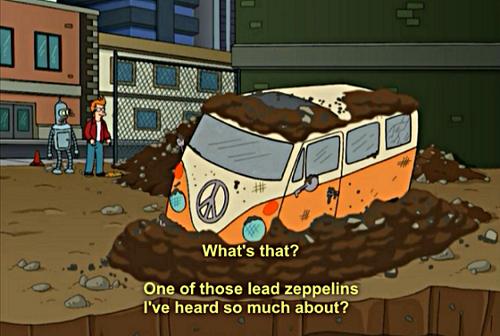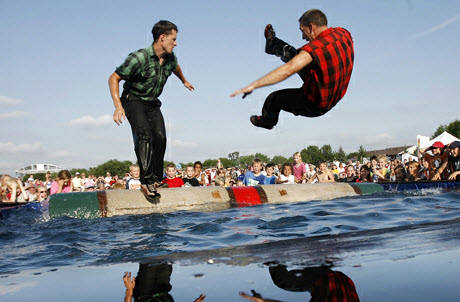Transporter

Hippie Van Type 2. Mine was scrapped. Its recycled steel is probably in the Escalade that cut you off this morning.

Stretching your VW bumpers helps prevent shin splints.
Officially, it is a Transporter Type 2. No one actually called it that. You know it as a VW Bus, VW Van or hippie van. Mine, a 1971, wasn't as noble as the cool camper version; it was pretty much an ordinary van minus the middle seat which suited me fine as I was as often toting a bicycle or sailing gear as anything else. When people find out that I used to have it, the usual reaction is, "that's cool." Somehow, they have images of road trips with either Led Zepplin's "Immigrant Song" or Simon and Garfunkel's "(Look for) America".
It was handy to have at the time, a period in my life when I seemed to move every six months. I have good memories of it. It even carried my first windsurfer, a 40 lb Ten Cate. But, the truth is, as a car, it sucked. It's most worthy attribute was the open interior. Everything else about it was between awful to outright deadly.
For a vehicle with the aerodynamic profile of a cinder block, it had all of a 50 hp 1.6 ltr engine. The manual specified a top speed of 62 mph (100 kph). If you ignored this and, instead, ran it at 70 (4900 rpm!) by drafting trucks, it would take about 6-9 months before the main bearings would burn and begin leaking copious amounts of oil which not only was needed to lubricate the engine but to help cool it. For all of its dependence on oil, the oil filter was a wire mesh strainer.
Its ignition system was about as dodgy - fortunately, the large interior allowed me to keep my tools on hand for those road side tune ups. Maintaining my own van meant learning to install points and condenser, gap the spark plugs and adjust the valves on a very regular basis.
Driving it was always a thrill. There were hills on the interstate that I could only climb at 55 mph by literally mashing the pedal to the floor. Passing trucks would give it a good shove - I learned to anticipate and turn the wheel into the turbulence before the truck moved alongside. Strong crosswinds could almost push it off the road.
Air conditioning? You rolled it (the windows) down. That really improved the aerodynamics.
Well, you say, at least it got good gas mileage. Not even that - pushing that big, flat front end through the air meant its little engine couldn't do much more than 21-22 mpg on the highway. As it banged away, I couldn't hear the AM radio over it. I wasn't even listening to Zeppelin anyway but some crappy sports talk station in St. Louis (oh, how those AM signals bounced at night).

In the future, the Transporter will be revered.
These were merely its inconveniences. When it wasn't being a pain in the rear, it was threatening to kill you. The heating system depended on air blown over the exhaust pipes. Any leak in the exhaust (which wasn't unusual) meant that, in the winter, you had to choose between hypothermia, carbon monoxide poisoning or some combination of the two.
With its rear engine and your sitting in front of the front wheels, effectively, your shins were the front bumper. Sure there was a single layer of sheet metal a few inches in front of them, but, let's be honest. If you hit anything, including a sparrow, the front end would be pushed beyond your knee caps. Frankly, that didn't matter as the steering wheel was horizontal like a bus's. In any serious accident, it would crush your spine making the condition of your legs pretty much immaterial.
Years later, every so often I'd think that I shouldn't have had it towed away for scrap, what a fun car it would have been to have and restore. My temporary insanity would pass after I'd remember what a total piece of crap it was compared to my subsequent minivans. The latest, a Honda Odyssey, has almost five times the horsepower, 40% better gas mileage, satellite radio, air bags all around and goes 120,000 miles between tune-ups.
The VW van did the job it was supposed to do at the time. Sure, it had its shortcomings but it was all I had and could afford. Most people couldn't have put up with the constant maintenance, acceleration that was timed with a calendar and threat of severe bodily harm. I'd never own one now, as even my old Plymouth minivan is incomparably better and won't kill me if I hit a shrub. You may see one around every so often; they have that retro/vintage cachet. Certainly, almost no one would own one for its utility or performance.
Recently, someone posted an ad for a "vintage" windsurfer on our forums. Our reactions ranged from "just chuck it" to "it would be good for something other than windsurfing" to "well, somebody might be able to make it work if nothing else could be had." Each was a reaction and opinion based on decades on windsurfing, each had merit.
Gene mentioned that, for all its drawbacks as a windsurfer, it might serve as a budget SUP. Curious, I searched for some feedback on how well old windsurfers act as SUPs.
http://www.sup-talk.co.nz/?p=1
I’d like to order one of your alu paddles please. [the very cheapest model we have, probably the lowest price paddle available in the entire country]
Sure! Just out of interest, what board do you have?
Ah… Well, I don’t actually have a board yet. But we have an old windsurfer that we’re going to use – which is why I just want a really cheap paddle to start with. If we like paddleboarding, then maybe we’ll invest in some better kit…
At which point we sigh inwardly, and chalk another one onto the office wall. It’s a tricky one. The easiest option at this point would be to simply make the sale, put the money in the bank and despatch the paddle. However, there’s a 50/50 chance that the windsurf board they’ve got is actually going to be entirely unsuitable for SUP, they’ll have a really bad time on it, and that’s a potential convert lost to the sport. But if we tell them that, there’s a good chance that it’ll kill off their nascent enthusiasm to try the sport then and there – so the potential convert is lost anyway."
My own reaction (since you didn't ask) is that old boards (narrow, pre-1990) ultimately do more collective harm than good to a beginner. One can find the case where the board will work but way more often than not, it serves more as an impediment rather than an introduction to windsurfing.
And, that's the crux of the problem in my opinion, not whether one can learn on it but the probability that it will dissuade instead of encourage. My speculation is that in windsurfing, the likelihood that someone sailing a board like that converts them to a windsurfer is significantly lower than 50%.

He's looking smug because he's just bet against you learning on that durn thing.
When discussions like this arise, often they are accompanied by anecdote. "I learned on a board like this." "I found one in the shed and gave it a go." Or from the counterpoint, "We had a friend, a teenager, use a harness on his third day on a wide board. Kids have to walk off wide boards to get off. They windsurf without dealing with falling off and climbing back on."
The reality is that in broad terms, boards like this did a poor job of helping people become windsurfers. Through the late 80s and 90s, the windsurfing industry began to realize that people weren't learning; they weren't becoming windsurfers. Hundreds of thousands of boards had been sold but most of them were now sitting in garages, basements and storage sheds rather than being sailed. Their owners weren't taking the next steps like planing, racing or just using it on a regular basis. Sure, they worked for somebody - pretty much most of us over a certain age we won't mention - but they didn't work for tens, if not hundreds, of thousands more.
Only a limited population of beginners could use the old, narrow boards without gymnastics, feats of strength, or blind, clinical almost pathological OCD determination. For those outside the ideal range of 130-180 lbs, the boards could be from annoying to simply sadistic. On one end of the spectrum were small women and children struggling with the heavy, over-sized rig. On the other were the 200+ lb guys who were trying to learn on, what was for them, a sinking, rolling log.

Learn to Windsurf Day circa 1995
Now, even for those who fit the physical and/or mental profile for sailing one, older boards present multiple challenges including an absence of spare parts and that windsurfing technology has progressed so much that almost no part of an older board and rig can reasonably be migrated to a newer set up.
Board makers realized things had to change if they were going to stay in business. Wider, more stable boards began to appear beginning in the mid/late 1990s - the Revo, Go, Start, Discovery, Prodigy, Nova - with rigs to match. Most of these boards not only were appropriate for beginners but could be enjoyed by more experienced windsurfers. Learning to windsurf stopped being a painful initiation only for the manically devoted.
My distaste for "vintage" (not true vintage boards like the Mistral Superlight) windsurfers isn't based on that they aren't good for anyone. There will be those occasional souls who happen on a freebie, give it a go and end up enjoying it. However, the odds are against that occurring. Most often, gets dragged out to the lake one day, tortures its new owners for a couple of hours and then sent back to the basement where it waits silently and patiently for its next victims.

A Dufour Wing waits for its next passenger.
Would a lesson help in learning on an old board? Sure, just like a lesson will help you learn to snow ski on old wooden skis and leather boots. It makes a bad idea less bad. More than likely, anyone who is cheapening out and thinking spending $100 for an old tank instead of $300-400 for a better set up rarely is the type that thinks spending $60 or $150 for a lesson or clinic is a good idea.
Are old boards all bad? Of course not. I could see using one, say, at Burning Man.

For a different take on the "vintage" boards referred to in this article:
http://windsurfatlanta.org/Forum/viewtopic.php?f=5&t=3814&p=14860&hilit=#p14860
Some more VW pics... http://61dc.com/?p=29
Bill Herderich
New VW Bus...
https://finance.yahoo.com/news/volkswagen-officially-unveils-its-id-buzz-ev-181057412.html
Bill Herderich
Bad news: 300 miles per charge
Good news: that's about as far as my original Type 2 would go before you'd have to reset the points and timing. Changing the distributor to a Bosch electronic was a big performance upgrade.
Wish they could extend the range a bit - a worthy successor someday to the Transit.
I love VW vans but it needs to be a Gas/Electric/Sail drive for days like today.
Alan